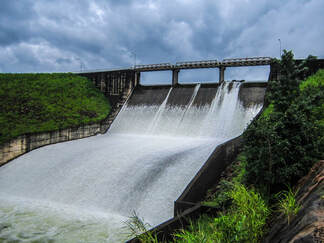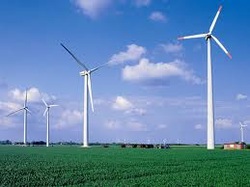 Hydropower is the process of harnessing energy from water. Dams are the most common example of hydropower, and the largest producers of this type of electricity are China, Brazil and Canada. As of 2016, this power source accounted for 71% of the world's renewable energy supply. Hydropower currently makes up 7% of total U.S. energy production, providing more power than wind or solar. While it's a renewable source, it's not without impact. The U.S. does not currently use most of its dams for hydroelectricity, and experts have criticized them in recent years due to their environmental and social impact. However, new technologies are improving how these plants operate, substantially reducing their impact on the surrounding ecosystem, specifically fish and other aquatic life. In addition to committing to other sustainable resources, there are increasingly new opportunities for the U.S. to advance hydroelectric energy production, primarily through retrofitting old plants. Innovations in renewable technology have been an integral part of discussions, as many U.S. states make promises to transition to more eco-friendly techniques. The Pros of Hydroelectric Energy Just like wind and solar technologies, hydropower has crucial pros and cons to consider. It's essential to weigh the advantages against the negative impact on the surrounding ecosystem. Impact also varies greatly depending on the type of system and scale of the project. For example, in-stream turbine technology has less of an effect than conventional dams. Zero-Carbon Hydropower is a carbon-free energy system. In comparison, coal has a carbon content of 78% and releases about 204.3 pounds of the gas per million Btu when burned. Domestic Hydropower provides a domestic source of energy, creating autonomy in local communities and reducing the need to rely on external or imported resources, such as oil. Predictable Hydropower provides reliable and consistent energy, often referred to as it's baseload power. This feature gives this energy source an advantage over wind and solar since their supply is weather-dependent. Hydropower can also store energy, offering providers control over the excess. The Cons of Hydroelectric Energy While this power source has significant advantages, you should also consider the drawbacks. Environmental Disturbance Hydroelectric plants disrupt and alter the ecosystem around them. One of the main criticisms is the impact on aquatic life, primarily fish migration and biodiversity. These issues are crucial considerations considering that dam construction can come with an irreversible effect. Sociocultural Impact Large-scale dams can damage local communities. Depending on the size of the project and the surrounding environment, the construction of hydroelectric dams can cause populations to be forcibly removed and alter the quality of drinking water downstream. The Future of Hydropower Today, workers remove more U.S. dams than build new ones. The key to promoting hydropower as a reliable and sustainable energy source is to innovate the technologies behind the infrastructure. By improving the conventional methods of producing this power and retrofitting the current infrastructure, the U.S. can tap into a powerful resource. Innovative technology within hydroelectric plants could potentially reduce greenhouse gas emissions by more than 5 billion metric tons. The next step will focus on new, smaller units that better adapt to the environment. In-stream turbine technology provides an alternative to conventional dams. Similar to historic grain mills, this system harnesses hydrokinetic energy without dramatically altering the natural flow of water. The primary benefits of in-stream turbine systems include being less ecologically disruptive, more conducive to healthy aquatic life and less impactful on the surrounding ecology. One model, the Alden turbine, focuses on fish passages, or hydraulic structures that do not impede migration. Hydropower is an underutilized technology when it comes to finding sustainable energy alternatives. The potential is expansive, and the benefits of new systems provide a reliable alternative to wind and solar options. With the innovation taking place within the industry, the opportunity to expand in the U.S. is significant. Bio: Emily Folk is passionate about environmental sustainability and more of her work can be found on her site, Conservation Folks, or follow her on Twitter for her latest updates. As international concerns over climate change grow, the number of eco-friendly homes is increasing. Eco-friendly homes have now become more than just a trend. In the future, eco-friendly homes are likely to be essential, as more and more people strive to protect the environment. More environmentally friendly methods are being incorporated into the design of homes, with designers using sustainable materials. Many homeowners are also taking steps to transform their home into an eco-friendly environment.
Eco-friendly homes are becoming more popular, as more homeowners begin to understand the importance of them. These types of homes not only help the environment but also enable you to save money. Many homeowners are now making changes to their home, such as using low-energy light bulbs, in order to lower their bills and make their home more energy efficient. Eco-friendly homes are not only better for the environment but also provide a healthier living environment for the homeowner. The materials used to construct an eco-friendly home are recycled and are less likely to emit any harmful gases or chemicals. An eco-friendly home is also less likely to experience problems that a regular home often experiences, such as damp or mold. This is due to an eco-friendly home containing more green materials and making better use of sunlight and water. Eco-friendly homes also have better air circulation and with features such as carbon monoxide alarms being installed to warn of boiler problems, these types of homes offer a much safer living environment. An eco-friendly home enables you to cut down on spending due to it being far more energy efficient. In addition to low-energy light bulbs, other energy-saving methods are being introduced. Solar panels are becoming a popular choice for homeowners, as they enable you to lower your energy bills. An eco-friendly home will also require less money to be spent on maintaining it thanks to the durable materials used in its construction. In America, communities are working hard to create more eco-friendly homes. Many areas in America now offer new eco-friendly homes to buy. In Denver, Colorado, the former airport site of Stapleton was transformed into public parks and now includes a residential area with Energy Star certified homes, some of which have been fitted with solar panels. New homes in Grand County are also designed to help you save money on your energy bills. In Salem, Oregon, the Pringle Creek community is one of the greenest in the country, with restored historic buildings and geothermal heating in over 60 homes. The increase in popularity of eco-friendly homes highlights their importance for the future. More and more homeowners are now choosing to focus on how eco-friendly a home is rather than just its overall appearance. An eco-friendly home has much more to offer and with more people taking an interest in green living, ever increasing numbers of sustainable buildings are likely to be created in the future.  COLUMBUS, Ohio -- The Blue Creek Wind Farm in Van Wert and Paulding counties is Ohio’s largest with more than 150 wind turbines that produce 350 megawatts of power. The developer benefited from a federal wind energy tax credit valued at about 2.2 cents per kilowatt-hour of energy. Bill Spratley, executive director of Green Energy Ohio says Blue Creek is a towering testament to the growth of wind energy in recent years. "It was the biggest private investment in Ohio, $600 million in the year 2011 followed by auto plants and other factories, so these are enormous investments,” Spratley said. Julian Boggs, state policy advocate for Environment Ohio, said Ohio’s wind energy capacity has grown from 10 megawatts in 2010 to more than 400 megawatts currently. "Ohio actually, in 2011, had the largest increase in wind capacity of any state and it's certainly a growing economy here," Boggs said. Source: NBC4i.com , Green Energy Ohio Newsletter TEAM GEMINI TO DEVELOP GREEN ENERGY PARK USING FUEL CREATED FROM WASTE |
Sponsored By:
Archives
January 2023
Categories
All
|


 RSS Feed
RSS Feed
